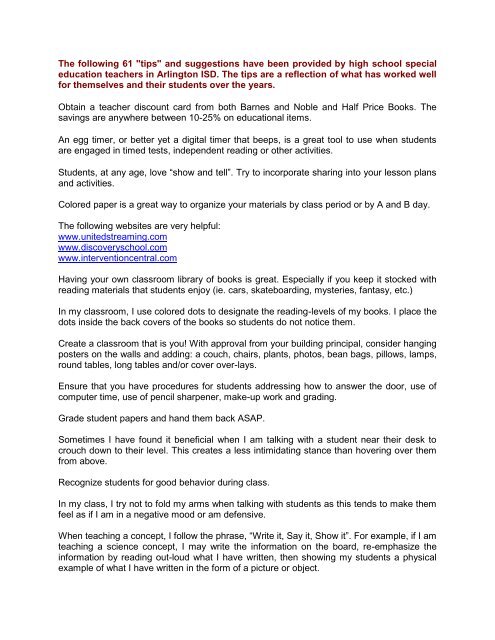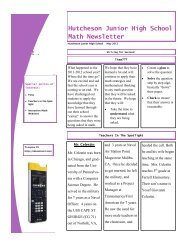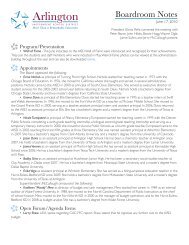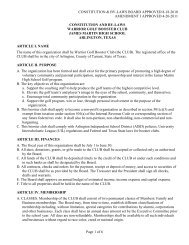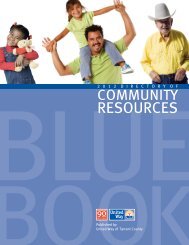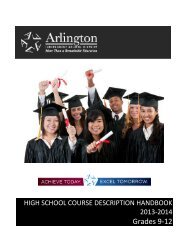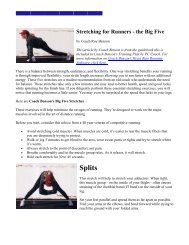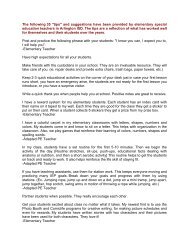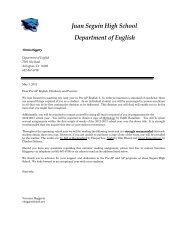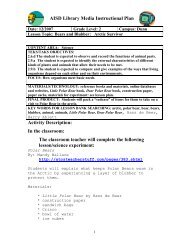"tips" and suggestions have been provided by high school special ...
"tips" and suggestions have been provided by high school special ...
"tips" and suggestions have been provided by high school special ...
Create successful ePaper yourself
Turn your PDF publications into a flip-book with our unique Google optimized e-Paper software.
The following 61 "tips" <strong>and</strong> <strong>suggestions</strong> <strong>have</strong> <strong>been</strong> <strong>provided</strong> <strong>by</strong> <strong>high</strong> <strong>school</strong> <strong>special</strong>education teachers in Arlington ISD. The tips are a reflection of what has worked wellfor themselves <strong>and</strong> their students over the years.Obtain a teacher discount card from both Barnes <strong>and</strong> Noble <strong>and</strong> Half Price Books. Thesavings are anywhere between 10-25% on educational items.An egg timer, or better yet a digital timer that beeps, is a great tool to use when studentsare engaged in timed tests, independent reading or other activities.Students, at any age, love “show <strong>and</strong> tell”. Try to incorporate sharing into your lesson plans<strong>and</strong> activities.Colored paper is a great way to organize your materials <strong>by</strong> class period or <strong>by</strong> A <strong>and</strong> B day.The following websites are very helpful:www.unitedstreaming.comwww.discovery<strong>school</strong>.comwww.interventioncentral.comHaving your own classroom library of books is great. E<strong>special</strong>ly if you keep it stocked withreading materials that students enjoy (ie. cars, skateboarding, mysteries, fantasy, etc.)In my classroom, I use colored dots to designate the reading-levels of my books. I place thedots inside the back covers of the books so students do not notice them.Create a classroom that is you! With approval from your building principal, consider hangingposters on the walls <strong>and</strong> adding: a couch, chairs, plants, photos, bean bags, pillows, lamps,round tables, long tables <strong>and</strong>/or cover over-lays.Ensure that you <strong>have</strong> procedures for students addressing how to answer the door, use ofcomputer time, use of pencil sharpener, make-up work <strong>and</strong> grading.Grade student papers <strong>and</strong> h<strong>and</strong> them back ASAP.Sometimes I <strong>have</strong> found it beneficial when I am talking with a student near their desk tocrouch down to their level. This creates a less intimidating stance than hovering over themfrom above.Recognize students for good behavior during class.In my class, I try not to fold my arms when talking with students as this tends to make themfeel as if I am in a negative mood or am defensive.When teaching a concept, I follow the phrase, “Write it, Say it, Show it”. For example, if I amteaching a science concept, I may write the information on the board, re-emphasize theinformation <strong>by</strong> reading out-loud what I <strong>have</strong> written, then showing my students a physicalexample of what I <strong>have</strong> written in the form of a picture or object.
I <strong>have</strong> learned that if I am patient <strong>and</strong> wait at least 3-10 seconds for students to respond toa question, they usually come up with the correct response. Some days it is hard toremember the 3-10 second rule, but it seems to work. I do <strong>have</strong> to remember that studentsprocess information at different rates.Don’t ever <strong>have</strong> students do a journal just to keep them busy <strong>and</strong> quiet. Writing shouldalways <strong>have</strong> student purpose.-High School Resource English TeacherWhen you write information on the chalkboard/whiteboard, draw boxes around groups ofsimilar ideas. The boxes help students visually zero in on the information.When you create a test for your students, space-out your questions <strong>and</strong> answers. Morewhite space on a page helps many students focus better.Greet students at your classroom door every class period. This will create a warm, invitingatmosphere <strong>and</strong> you can also check for IDs <strong>and</strong> dress code compliance at this time.Have a “bell-ringer” on the board at the beginning of every class for students to work on asyou take attendance.Create a “Substitute Binder” that contains class procedures <strong>and</strong> expectations, a <strong>school</strong>map, the <strong>school</strong> crisis plan, a <strong>school</strong> phone number list (with the most important numbers<strong>high</strong>lighted - i.e., APs, Security), referrals, hall passes, MAC passes, class lists <strong>and</strong>anything else that may be important for the sub to <strong>have</strong>. The substitute binder can alsocontain emergency lesson plans in case you are out unexpectedly.Encourage your students to underst<strong>and</strong> what they will be facing in the future. Also, relayyour own personal experiences of <strong>high</strong> <strong>school</strong> to them as examples. Tell your students theyare no longer “students” when they engage in science experiments. Rather, they are all“scientists”.-High School VAC Science TeacherWhen my students enter my room, I already <strong>have</strong> their first box job sitting on theirdesk. Students go right to work <strong>and</strong> don't <strong>have</strong> time to focus on other things.-High School VAC TeacherBe consistent in whatever you do. It may be hard from the beginning, but you’ll spend lesstime re-teaching something when you are consistent.-High School ABLE TeacherFirst, fall in love with poetry no matter what subject you teach. Second, read <strong>and</strong> know thestories you teach, along with some interesting "juicy" background information on the author,or the time period. This gets students interested. Third, h<strong>and</strong> out awards to students as theylove to receive praise. My prize bin has won over reluctant learners. Visit the Dollar Store<strong>and</strong> load up once a semester. Students in my class earn tags to write their name onthroughout the period <strong>and</strong> then I draw one or two names/tags at the end of class. It is greatto walk around <strong>and</strong> monitor positive behavior, or good work <strong>and</strong> give them a tag (slip of
paper). If a student walks in the door with an ID on, grabs their journal <strong>and</strong> gets busywithout being told, follows directions, or comprehends the daily task(s), etc., I h<strong>and</strong> outthese tags for potential rewards.-High School Resource English TeacherAssign students a specific numbered calculator to use during his/her class period. Keep thecalculators in a see-through shoe holder <strong>by</strong> your desk. By placing them there, you canquickly glance between each class period to see if all of the calculators are returned <strong>and</strong>you can identify who used the calculator last, if any problem arises.-High School Resource Math TeacherForm meaningful <strong>and</strong> working relationships with your <strong>school</strong>’s secretaries <strong>and</strong> custodians.They are an invaluable resource.Proximity control addresses most behavior issues. If an issue arises in the classroom, moveclose to where the action is occurring. Your presence in the classroom means a lot.“Visual Schedules” with students who are cognitively delayed are a must. Just because itappears that a student underst<strong>and</strong>s his/her schedule does not mean that he/she does notneed to follow his/her visual schedule. Visual schedules are comforting <strong>and</strong> the only form ofreading some students underst<strong>and</strong>.-High School Senior Alternate Curriculum TeacherParents desire to hear positive things about their child. For a student who is strugglingacademically or behaviorally, make it a point to call the parents when positive things occur.Create structure <strong>and</strong> consistency within the classroom. For example, when your studentsenter your classroom, <strong>have</strong> them get their spiral/notebook, sit down in their assigned desk<strong>and</strong> read what is on the board. This example of a routine allows students to know exactlywhat is going to be expected from them at the beginning of each class period in your room.Structure <strong>and</strong> consistency decrease anxiety for the student.-High School Resource English TeacherBe consistent in your classroom rules <strong>and</strong> proceduresGet to know each of your students’ interests. In turn, allow your students to get to know you,within professional boundaries. Talk to them about their interests, even if it means you <strong>have</strong>to learn about cars <strong>and</strong> trucks!Teach <strong>by</strong> example using demonstrations daily (ie. how to write an outline, how to edit one’spaper). You can use the white board, overhead, <strong>and</strong>/or digital presenter for yourdemonstrations.-High School Resource English TeacherClearly explain to your students what you want them to do or be doing <strong>and</strong> let them knowwhat they are doing right.Regularly emphasize the importance of learning <strong>and</strong> doing well, as well as how learningbenefits them for their futures.
Use humor in your teaching!Be a cheerleader; encourage your students regularly <strong>and</strong> help them see their self-worth.Provide positive feedback to them.Know where your students are academically (ie. reading, writing, <strong>and</strong> math-levels). Adjusttheir work, as needed, based on their individual needs.Students need continual repetition <strong>and</strong> re-teaching to learn <strong>and</strong> master objectives.Contact parents with positive comments about their child.Attend the extra-curricular activities of your students.Say something that is sincere <strong>and</strong> positive to each student every day.Prepare completely for the next teaching day before you leave <strong>school</strong>.I start my math classes with a "POP QUIZ." My quizzes are actually activities that rangefrom popular teen text messages such as BRB (Be Right Back) or a review concept fromthe previous class. These activities engage my students the minute they walk in my room.-High School Resource Math TeacherWhen dealing with a particularly "reluctant learner," sit-down in front of them or to the side,<strong>and</strong> just calmly talk for a moment. This action may help them to re-focus.Visually structure your classroom <strong>and</strong> label everything. Get rid of all clutter.-High School Senior Alternate Curriculum TeacherWhen speaking to parents, make sure that you use the s<strong>and</strong>wich method (good things, notgood things, good things again). Parents are a valuable resource. They desire to hear bothpositive as well as constructive comments about their child. When you <strong>have</strong> new students<strong>and</strong> need information, parents should be one of the first people you call for information.In my classroom, I use the phrase, “caught being good”. My students like it when they arecaught being good. It encourages good behavior.-High School Senior Alternate Curriculum TeacherAlways use effective, specific praise with students. Generic praise does not <strong>have</strong> meaning.When you speak with a student about a behavioral issue, it might be best if you talk tohim/her away from their peers.-High School Science Co-TeacherCall home to parents to let them know when their child is really working hard <strong>and</strong> doinggreat in class. Encourage the parents to give their child some type of praise in turn.Set the tone for acceptable behavior from day one.
List your classroom rules <strong>and</strong> consistently enforce them.Let your students know that you care <strong>and</strong> in turn they will care about what you teach.Organize as much as possible. Always <strong>have</strong> a plan.Allow students to become physically involved in learning.Engage your students in the use of technology: computers, appropriate software, graphingcalculators, data projectors, etc.Manipulatives are a must-<strong>have</strong> for subjects – e<strong>special</strong>ly math <strong>and</strong> science. Get yourstudents engaged in h<strong>and</strong>s-on activities that relate to the text-book content.Make learning fun <strong>and</strong> keep your expectations <strong>high</strong>.Students are oriented toward novelty. Surprise students with change. Here are someexamples:1. Have students do math problems using several different colored pencils.2. Have students do a collective essay using markers on butcher paper.3. Cut up an old map of the U.S. <strong>and</strong> place in a “grab bag”. Have students blindly select astate. Then each student creates a one minute report on a state after 10 minutes ofcomputer research. Have a timer <strong>and</strong> limit each presenter to exactly one minute.4. When you do the “3 Minute Reading Assessments”, h<strong>and</strong> the timer to the student to startit <strong>and</strong> keep it until it goes off in 3 minutes.


